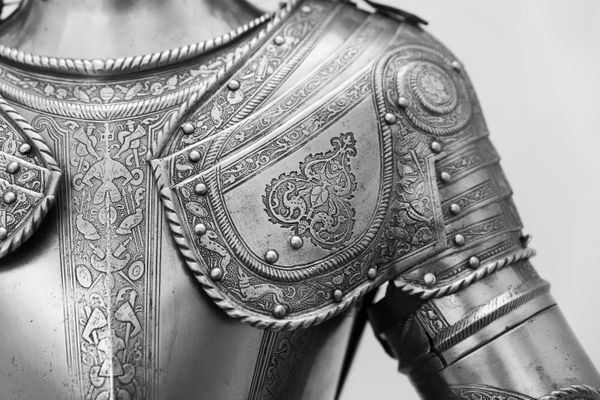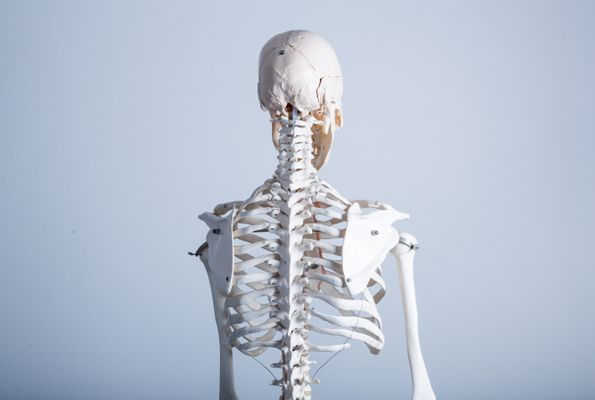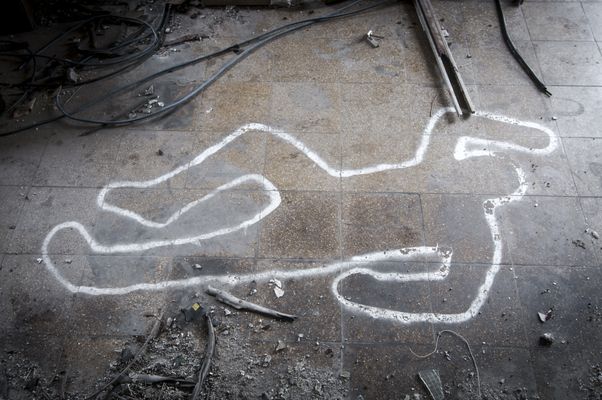4.1.3
Violence
Heroic Violence
Heroic Violence
Macbeth is shown to be a hero at the start because of his violent nature. He kills a traitor. Ironically, Macbeth ends up becoming the traitor that is murdered at the end of the play.


Macbeth
Macbeth
- The violent imagery describing Macbeth at the start of the play is honourable: his violence on the battlefield is for the king.
- He is praised and rewarded for killing a treacherous thane, Macdonald (sometimes spelt Macdonwald): ‘Till he unseam’d him from the nave to th’ chops / And fixed his head upon our battlements’ (1,2).
- Macbeth shows his courage and strength by cutting his enemy open from his navel (belly button) to his face.
- The violent verb ‘unseam’d’ emphasises how Macbeth opens him up.
- It all seems very fluid (free) in motion. This implies Macbeth is very strong and is unphased by horrifically killing another man.


Macdonald's head - message about treason
Macdonald's head - message about treason
- Macbeth removes his enemy’s head and displays it from the battlements. This might seem grisly, but it has a clear purpose.
- When Shakespeare was writing, anyone sentenced to death for treason, such as Guy Fawkes after the failed Gunpowder Plot, would be hung, drawn and quartered (a horrible punishment of partial hanging, disembowelling and cutting of body into quarters) and their heads would be shown on pikes on Traitor’s Gate. This was the gateway prisoners would pass through as they entered the Tower of London.
- This was done to make sure people thought twice before acting against their king and country.


Macbeth's head
Macbeth's head
- At the end of the play, Macduff removes Macbeth’s head.
- Macduff seems to be displaying it as he asks them to look at it: ‘Behold where stands / the usurper’s cursed head’ (5,9).
- This moment makes Macbeth’s heroism at the start somewhat ironic – he was a hero for killing a man who seems to have been a traitor to the king. However, almost immediately after that, he himself becomes a traitor, soon murdering the king and taking over Scotland.
- This relates back to the witches’ statement: 'Fair is foul, and foul is fair' (1,1) – things and people are not always what they seem.


Heroic code
Heroic code
- The warriors fighting believed in the heroic code (defines how a noble person should act): it was honourable to die in battle.
- This is why Siward says that his son ‘parted well’ (5,9). The battles were bloody and violent, but participating and fighting, even dying, bravely was very honourable. It deserved praise.
- This is why Macbeth’s murder of King Duncan seems particularly evil – he killed him while he slept, without warning.
- He did not give Duncan a chance to meet him equally in battle.
Lady Macbeth - Violent Imagery
Lady Macbeth - Violent Imagery
Lady Macbeth uses very violent imagery to persuade her husband to murder King Duncan. She tells him she would have bashed in the brain of her own baby if she had promised to do it: ‘I would, while it was smiling in my face, / Have plucked the nipple from his boneless gums, / And dashed the brains out, had I so sworn / As you have done to this’ (1,7).


Shocking (from a woman)
Shocking (from a woman)
- This would have been very shocking to a Jacobean (during the reign of James I of England) audience.
- Lady Macbeth is a woman whose main purpose, according to the values of the time, would be to give birth to and nurture children. The language she uses is very vivid and violent.


'Plucked'
'Plucked'
- The verb ‘plucked’ is simple, but devastating; it’s as if she casually removed the baby from the breast and broke the connection between them.
- In this sense, Lady Macbeth goes against nature by refusing to nurture her own child and, instead, describes the violent image of her murdering it.


'Boneless'
'Boneless'
- The adjective ‘boneless’ reflects how young the child is.
- He doesn’t have teeth in his gums yet. This reminds the audience of how vulnerable the baby is and how Lady Macbeth does not seem to care – again, her careless attitude goes against nature, especially for women at the time the play was set.


'Dashed'
'Dashed'
- Finally, the verb ‘dashed’ is a very aggressive one. It shows how she would have bashed in her baby’s head if she had promised to do it.


Analysis
Analysis
- She uses violence to try and show Macbeth how strong her commitment is to anything she promises to do.
- She is trying to show him he is a coward for going back on the plan.
- She uses an image of violence against the thing she cares most about – her baby. She does this to show him that she’d do anything to keep her word to him and to make him change his mind.
- In Lady Macbeth’s mind, this violent description shows her husband the extent she’d go to for him and, therefore, how much she loves him.
Murder and Violence
Murder and Violence
Violence leads to more violence in Macbeth. Macbeth murders the king and murders to protect his crown thereafter. He even orders for a child to be murdered.


Killing Duncan
Killing Duncan
- The violence of killing King Duncan is clear from the blood on Macbeth’s hands.
- King Duncan was sleeping. Macbeth was especially cowardly in the murder and he prevented him from a warrior’s death.
- Macbeth refers to his hands as ‘a sorry sight’ (2,2). This suggests that he has done something incredibly weak in murdering a sleeping man, and one who he was honour-bound (morally obliged) to serve and protect.


Other murders
Other murders
- After King Duncan’s murder, Macbeth steps away from murdering others with his own hands. He prefers to send murderers to do this for him.
- This may suggest he is still ashamed of using violence against those who don’t deserve it.
- Alternatively, this could show that he cares so little about human life that he carelessly gives the job of murdering to other people – his victims do not deserve his attention.


Violence bringing violence
Violence bringing violence
- Macbeth says after seeing Banquo’s ghost, ‘It will have blood they say: blood will have blood’ (3,4).
- This is a metaphor saying that once a violent act is committed, more violence will follow. This usually happens when a family tries to avenge (get revenge for) the first murder.


One murder after another
One murder after another
- One violent act causes more and more violence.
- After murdering King Duncan, Macbeth continues to kill others in an attempt to stop anyone else from taking his throne.
- He hires men to murder Banquo and his son.
- He hires men to murder Lady Macduff and her son.
- The guilt of murdering Duncan drives Lady Macbeth to suicide.
- The murder of Duncan, Lady Macduff, and her son causes Macduff to kill Macbeth.


Protecting the crown
Protecting the crown
- Macbeth will also stop at nothing to protect his crown. He punishes those disloyal to him, including women and children.
- He sends murderers to kill Banquo and his son, Fleance, who escapes.
- After Macduff leaves for England, Macbeth sends more murderers to kill his wife and children in their home.


Murdering children
Murdering children
- The murder of Macduff’s son is seen on stage: ‘he has killed me, mother’ (4,2).
- The murder of children is very violent and upsetting. Children are symbolic of innocence. They cannot protect themselves.
- Calling out to his ‘mother’ is very emotive (brings out feelings), because it reminds those watching of how young he is. This violence reflects how evil Macbeth has become.
1Literary & Cultural Context
2Plot Summary
3Characters
3.1Macbeth
3.2Lady Macbeth
3.3Other Characters
3.4Grade 9 - Key Characters
4Themes
4.1Themes
4.2Grade 9 - Themes
5Writer's Techniques
5.1Structure, Meter & Other Literary Techniques
6Recap: Main Quotes
6.1Characters Quotes
Jump to other topics
1Literary & Cultural Context
2Plot Summary
3Characters
3.1Macbeth
3.2Lady Macbeth
3.3Other Characters
3.4Grade 9 - Key Characters
4Themes
4.1Themes
4.2Grade 9 - Themes
5Writer's Techniques
5.1Structure, Meter & Other Literary Techniques
6Recap: Main Quotes
6.1Characters Quotes
Unlock your full potential with Seneca Premium
Unlimited access to 10,000+ open-ended exam questions
Mini-mock exams based on your study history
Unlock 800+ premium courses & e-books